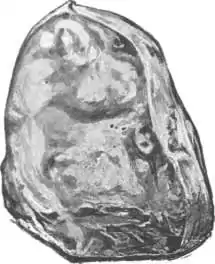Jagersfontein Mine
Jagersfontein Mine /ˌjeɪɡərzˈfɒnteɪn/ is an abandoned open-pit mine in South Africa, located close to the town of Jagersfontein and about 110 kilometres (68 miles) south-west of Bloemfontein.[1][2] Since it was first established in 1870,[3][4] two of the ten biggest diamonds ever discovered, the Excelsior and the Reitz (now called the Jubilee), were mined from Jagersfontein.[2] The term "Jagers" has since been coined to denote the distinctive faint bluish tint of the gems from this mine.[5] Among geologists, Jagersfontein is known as a kimberlite pipe,[6] and a prime locality for mantle xenoliths, some of which are believed to have come from depths of 300–500 km (190–310 mi).[1]

About 9.6 million carats (1,900 kg) of jewel-quality diamonds were extracted during the mine's century of operation, interrupted only by the two World Wars and the Great Depression.[2] After thirty-nine years of open-pit mining, underground mining began in 1909, and continued until its eventual closure on May 28, 1971; less than a year after the centenary of the first diamond discovery in the area.[3][5] Since then, an Open Mine Museum and the Jagers Mining Village have opened as tourist attractions at the site.
Research by historian Steve Lunderstedt in 2005 confirmed that the mine was the biggest hand-excavated hole in the world at 19.65 hectares (48.6 acres), slightly larger than the Big Hole of 17 ha (42 acres) in Kimberley, which had claimed the title up to then. It is probably not the deepest, though, since the final depth of the Big Hole reached 220 m (720 ft) or more. Jagersfontein was dug by hand to a depth of 200 m (660 ft) by 1911.[7]
Jagersfontein riots
Several miners strikes or ‘riots’ occurred between 1913 and 1914 in mines Koffiefontein, Klipdam, Randfontein, Kimberley, Premier mines and Jagersfontein mines. Deaths due to shootings in Premier mines and well as Jagersfontein mines led to higher publicity than other miners strikes which occurred during that time.
The majority of the miners who worked at these mines were Basotho people who lived in then Basotholand. During their time working in the mines, they lived in hostels which had strict rules for black people which included the necessity for the possession of a pass book.
Issues that affected Sotho people and precipitated riots included: The Great Depression, a drought over South Africa which was particularly severe over Basotholand as well as the first request that the British territories be handed over to the South African Union. The most distressing of these issues was the drought as it, compounded with the economic depression, put much pressure on migrant workers to return money back home to Basotholand.[10]
The ratio of women to men in Jagersfontein was 16:1 which was abnormal for a Free State town and as such a larger proportion of women participated in protests in Jagersfontein compared to others of its time. Nonetheless, authorities in Jagersfontein took drastic action on the women involved in the strikes including an event in March 1913 where police officials sealed off the bantu location, searched each house and demanded pass books at gun-point. Approximately 61 women were arrested, of which almost 50% were coloured.
Many Basotho people fled back to Basotholand for refuge after the shootings and brutality during the riots.
In 1914, the mining riots resulted in the deaths of 11 Basotho people.[11]
External links
References
- "Jagersfontein Mine, Jagersfontein, Free State Province, South Africa", Mindat.org
- Jagersfontein, Places.co.za
- Jagersfontein entry, Encyclopædia Britannica
- "Jagersfontein Mine", Showcaves.com
- "The Excelsior Diamond", Famous, Historic and Notable Diamonds, Tripod.com
- Photograph showing the circular geometry of the Jagersfontein kimberlite, Department of Terrestrial Magnetism, Carnegie Institution of Washington
Stressed Pyroxenite Nodules from the Jagersfontein Kimberlite, G. D. Borley and P. Suddaby, Mineralogical Magazine; March 1975 v. 40; no. 309; p. 6-12; doi:10.1180/minmag.1975.040.309.02
Iron carbide and metallic inclusions in diamonds from Jagersfontein, A. P. Jones, D. Dobson, I. Wood, A. D. Beard, A. Verchovsky, H. J. Milledge, 9th International Kimberlite Conference Extended Abstract No. 9IKC-A-00360, 2008 - "Big Hole loses claim to fame", Hannatjie van der Merwe, News24.com, May 20, 2005
- "Open Africa - Open Mine Jagersfonteign". Archived from the original on 2014-02-18. Retrieved 2014-07-20.
- Community takes on Mining Giants Archived 2016-03-03 at the Wayback Machine - The Weekly, 8 August 2013
- Scott Rosenberg, Richard F. Weisfelder. Historical Dictionary of Lesotho. Scarecrow Press, 13 Jun 2013 page xxv
- B Hirsun, J Wells and Judie Jancovich. What Ever Happened at Jagersfontein? pages 68-86